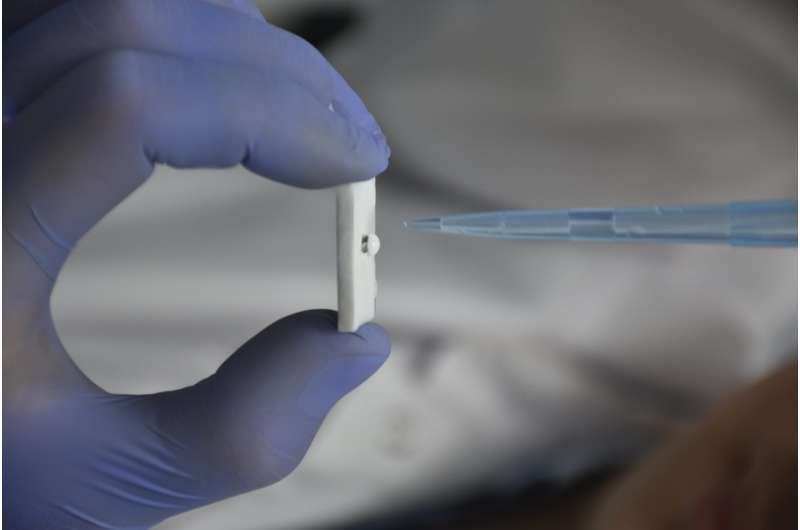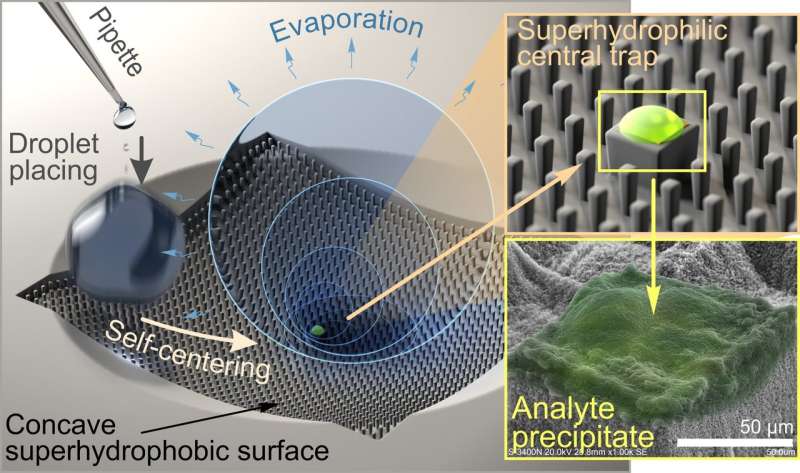Surfaces with controlled wettability to trap and identify molecules at trace concentrations

An international group of physicists from Far Eastern Federal University (FEFU), the Russian Academy of Sciences and Swinburne University of Technology (Australia) has developed a technology for trapping and chemical analysis of organic and non-organic molecules at ultra-low concentrations. The article was featured in Nanoscale.
The discovery leads to more productive solutions in microbiology, medicine, chemistry, and biochemistry by offering quick identification of dangerous and toxic substances, cancer markers, and metabolites of pathogenic microorganisms in trace concentrations.
Using Teflon as a substrate, the team created a special concentrator platform that enables a million-fold increase in concentration of the molecules being identified. The technology cuts down the time required for advanced biochemical analyses from several days to just a few hours.
"The key element of the concentrator is a micro- and nano-structured superhydrophilic (water attracting) trap surrounded by a superhydrophobic (water repellent) area," explains Alexey Zhizhchenko, a research associate of the Nanotechnology Research and Education Center, School of Engineering, FEFU. "In our concentrator, an ordinary liquid droplet plays the role of a container for controlled transport of the target molecules to the superhydrophilic trap. This transport is made possible by controlling the size and position of the droplet in the course of vaporization, which is achieved by tailoring and optimizing the wetting properties of the substrate. Up to 97 percent of the target molecules are then localized on the small trap, and their concentration increases more than 1 million times compared to its initial value. This leads to a dramatic enhancement of the optical response of the trapped molecules. By combining this feature with highly sensitive chemical detection properties of the trap, scientists are able to detect and identify target substances even if there are just a few hundred molecules in the droplet. Moreover, further optimization of the concentrator design can potentially result in single-molecule detection.

The concentrator platform is fabricated by direct laser recording on Teflon substrates with ultrashort pulses. The process does not require tight laser focusing and therefore takes only a couple of minutes to complete. The technology is versatile, relatively cheap, and can potentially be used for making new generations of biosensor platforms for highly accurate and sensitive chemical analyses.
Earlier this year, the same research team, as a part of an international workgroup of scientists, developed a technology for identifying trace concentrations of substances using a black silicon substrate platform. Due to its specific morphology, black silicon amplifies the Raman signal—the light scattered by the molecules being analyzed—and does not distort spectroscopic results due to its noninvasiveness, which means that it does not react with the substance in question.
More information: Alexey Zhizhchenko et al, On-demand concentration of analyte on laser-printed polytetrafluoroethylene, Nanoscale (2018). DOI: 10.1039/C8NR06119J
Journal information: Nanoscale
Provided by Far Eastern Federal University




















